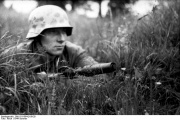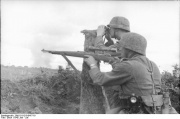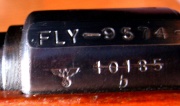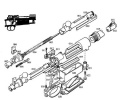Karabiner 98k
| |||||||||||||||||||||||||||||||||||||||||||||||||||||||||
The Karabiner 98 Kurz (often abbreviated Kar98k or K98k) was a bolt-action rifle adopted as the standard infantry rifle in 1935 by the German Wehrmacht,[1] and was one of the final developments in the long line of Mauser military rifles.
Contents |
[edit] General information
The Karabiner 98k was a controlled-feed bolt-action rifle based on the Mauser M 98 system. It could be loaded with five rounds of 7.92x57mm IS ammunition from a stripper clip, loaded into an internal magazine. It was derived from earlier rifles, namely the Karabiner 98b, which in turn had been developed from the Mauser Model 1898. The Gewehr 98 or Model 1898 had an internal, staggered row magazine of five cartridges within the receiver. Since the rifle was shorter than the earlier Karabiner 98b from which it was derived (the 98b was a carbine in name only, being identical in length to the Gewehr 98 long rifle), it was given the designation Karabiner 98 Kurz, meaning "Carbine 98 Short". Just like its predecessor, the rifle was noted for its reliability, good accuracy and an effective range of up to 500 meters (547 yards) with iron sights.[3]
[edit] Design details
The straight bolt handle found on the Gewehr 98 bolt had been replaced by a turned-down bolt handle on the Karabiner 98k. This change made it easier to mount aiming optics directly above the receiver on the Karabiner 98k. The standard Karabiner 98k tangent-type V-notch and post iron sights could be regulated for ranges from 100 m up to 2000 m in 100 m increments. The 98k rifle was designed to be used with an S84/98 III bayonet[4] and to fire rifle grenades. Most rifles had laminated stocks [5], the result of trials that had stretched through the 1930s. Plywood laminates resisted warping better than the conventional one-piece patterns, did not require lengthy maturing and were less wasteful. Starting in late 1944, 98k production began transition to the Kriegsmodell" ("war model") variant. This version was simplified to meet wartime production demands, removing the bayonet lug, cleaning rod, stock disk, and other features deemed to be unnecessary.[6]
The 98k had the same disadvantages as all other turn-of-the-century military rifles in that it was comparatively bulky and heavy, and the rate of fire was limited by how fast the bolt could be operated. Its magazine had only half the capacity of Great Britain's Lee-Enfield series rifles, but being internal, it made the weapon more comfortable to carry. A trench magazine was also produced that could be attached to the bottom of the internal magazine by removing the floor plate, increasing capacity to 20 rounds, though it still required loading with 5 round stripper clips. While the Allies (both Soviet and Anglo-American) developed and moved towards standardization of semi-automatic rifles, the Germans maintained these bolt-action rifles due to their tactical doctrine of basing a squad's firepower on the unit's light machine gun and possibly their problems of mass producing semi-automatic rifles.
In close combat, however, submachine guns were often preferred, especially for urban combat where the rifle's range and low rate of fire were not very useful. Towards the end of the war, the Karabiner 98k was being phased out in favour of the StG44 assault rifle, which fired the 7.92x33mm Kurz intermediate rifle round that was more powerful than the pistol cartridges of submachine guns, but that could be used like a submachine gun in close-quarters and urban fighting. Production of the StG44 was never sufficient to meet demand, being a late war weapon, and because of this the Mauser Karabiner 98k rifle was still produced and used as the standard infantry rifle by the German forces until the German surrender in May 1945.
[edit] Rifle grenade launcher
As of 1942 an attachable rifle grenade launcher called the "Gewehrgranatengerät" or "Schießbecher" (shooting cup) was introduced that was developed based on rifle grenade launcher models designed during World War I. The 30 mm Schießbecher cup-type rifle grenade launcher could be mounted on any Karabiner 98k and was intended to replace all previous rifle grenade launcher models. The rifle grenade launcher could be used against infantry, fortifications and light armored vehicles up to a range of 280 m (306 yd). For these differing tasks several specialized grenades with accompanying special propelling cartridges were developed for the 1,450,113 produced Schießbecher rifle grenade launchers. The rifle grenade propelling cartridges fired a wooden projectile trough the barrel to the rifle grenade that upon impact automatically primed the rifle grenade. The Schießbecher could also be mounted on the Karabiner 98a, G98/40, StG44 and FG42.[7]
[edit] Variants
Several special models of the Karabiner 98k existed.
For snipers, Karabiner 98k rifles selected for being exceptionally accurate during factory tests, were fitted with a telescopic sight as sniper rifles. Karabiner 98k sniper rifles had an effective range up to 800 meters (875 yards) when used by a skilled sniper. The German Zeiss Zielvier 4x (ZF39) telescopic sight had bullet drop compensation in 50 m increments for ranges from 100 m up to 800 m or in some variations from 100 m up to 1000 m. There were also ZF42, Zeiss Zielsechs 6x and other telescopic sights by various manufacturers like the Ajack 4x, Hensoldt Dialytan 4x and Kahles Heliavier 4x with similar features employed on Karabiner 98k sniper rifles. Several different mountings produced by various manufacturers were used. The Karabiner 98k was not designed for mounting telescopic sights. A telescopic sight mounted low above the receiver will not leave enough space between the rifle and the telescopic sight body for unimpaired operation of the three-position safety catch lever. This ergonomic problem was solved by mounting the telescopic sight relatively high above the receiver and sometimes modifying the safety operating lever for more comfortable operation. Approximately 132,000 of these sniper rifles were produced by Germany.[8]
For Fallschirmjäger (German paratroopers) special versions of the Karabiner 98k that could be transported in shortened modes were produced. Specimens with folding stocks as with unscrewable barrels are known.[9]
The G40k with a barrel length of 490 mm and 3.2 kg weight was a shortened version of the Karabiner 98k.[9][8] A batch of 82 G40k rifles was produced in 1941. A reverse engineering simulation with QuickLOAD internal ballistic software for the 8x57mm IS cartridge loaded with the German standard sS (schweres Spitzgeschoß/heavy pointed bullet) ball bullet, predicted that this shortening of the barrel results in ≈ 35 - 60 m/s muzzle velocity reduction depending on the propellant used. Due to its significant lighter weight the G40k produced ≈ 20% more recoil compared to the Karabiner 98k standard rifle.
[edit] Pre-World War II export
Though most Karabiner 98k rifles went to the German armed forces, the weapon was sold abroad in the years prior to World War II. In Portugal, a large quantity of Karabiner 98k rifles made by Mauser Werke were adopted as the 7.92 mm m/937 infantry rifle.[10][11]
[edit] Combat use
[edit] World War II

The Mauser Karabiner 98k rifle was widely used by all branches of the armed forces of Germany during World War II. It saw action in every theatre of war involving German forces, including occupied Europe, North Africa, the Soviet Union, Finland, and Norway. Although comparable to the weapons fielded by Germany's enemies at the beginning of the War, its disadvantages in rate of fire became more apparent as American and (to a lesser extent) Soviet armies began to field more semi-automatic weapons among their troops. Still, it continued to be the main infantry rifle of the Wehrmacht until the end of the War. Resistance forces in German-occupied Europe made frequent use of captured German 98k rifles. The Soviet Union also made extensive use of captured Karabiner 98k rifles and other German infantry weapons due to the Red Army experiencing a critical shortage of small arms during the early years of World War II. Many German soldiers used the verbal expression "Kars" as the slang name for the rifle.
[edit] Post-World War II
During World War II, the Soviet Union captured millions of Mauser Karabiner 98k rifles and re-arsenaled them in various arms factories in the late 1940s and early 1950s. These rifles were originally stored in the event of future hostilities with the Western democracies. These rifles, referred to by collectors as RC ("Russian Capture") Mausers, can be identified by a crude "X" stamp on the left side of the receiver. The Soviet arsenals made no effort to match the rifles' parts by serial number when reassembling them, and some parts (the cleaning rod, sight hood, and locking screws) were deemed unnecessary and melted down for scrap metal.
Most of these rifles were eventually shipped to communist or Marxist revolutionary movements and nations around the world during the early Cold War period. A steady supply of free surplus military firearms was one way that Moscow could support these movements and states without giving them the latest Soviet infantry weapons.
One example of the Soviet Union providing the Mauser Karabiner 98k rifle (as well as other infantry weapons captured from the Germans during and after World War II) to its communist allies during the Cold War period occurred during the Vietnam War with the Soviet Union providing military aid to the armed forces of North Vietnam and to the NLF in South Vietnam.
A considerable number of Soviet-captured Mauser 98k rifles (as well as a number of 98k rifles that were left behind by the French after the First Indochina War) were found in the hands of NLF (Vietcong) guerrillas and VPA (NVA) soldiers by U.S. and Allied forces alongside Soviet-bloc rifles like the Mosin-Nagant, the SKS, and the AK-47.
In the years after World War II, a number of European nations that were invaded and occupied by Nazi Germany used the Mauser Karabiner 98k rifle as their standard-issue infantry rifle, due to the large number of German weapons that were left behind by the Germans in the later years of World War II. Nations like France and Norway used the Mauser Karabiner 98k rifle and a number of other German weapons in the years after World War II. Norway's captured Karabiner 98k rifles were usually rebarreled for the American .30-06 Springfield round, with a small cutout on the receiver so that the slightly longer round could still be loaded with stripper clips. Many of these conversions were rechambered again to 7.62 mm NATO. Some actions from Mauser Karabiner 98k left by German armed forces in 1945 were used by Kongsberg Våpenfabrikk (currently Kongsberg Small Arms) for building both military and civilian sniper/target rifles under the Kongsberg Våpenfabrikk Skarpskyttergevær M59 - Mauser M59 and Kongsberg Våpenfabrikk Skarpskyttergevær M67 - Mauser M67 designations. These rifles were used by the Norwegian armed forces up to the 2000s.
Many of the liberated European countries continued production of rifles similar to the Karabiner 98k, for example Fabrique Nationale (FN) in Belgium and Česká Zbrojovka (CZ) in Czechoslovakia produced both their proprietary older models and brand new Karabiner 98k rifles, many of which were assembled from leftover German parts or using captured machinery. In Czechoslovakia it was known as P-18 or puška vz.98N, the first being the manufacturer's cover designation of the type, the second official army designation - rifle model 98, N for německá - German. In Romania, the Czechoslovak version was known under the informal name of ZB, after Zbrojovka Brno - the Czechoslovak state producer of small weapons and munitions - and it was used to arm Romania's Patriotic Guards, before sufficient numbers of AKM rifles were made available for them. From 1950 to 1965, Yugoslavian Zastava also produced a near-copy of the Karabiner 98k called the Model 1948, which differed only from the German rifle in that it had the shorter bolt-action of the Czechoslovakian M1924 series of rifles. In addition, until 1953, the Spanish continued manufacturing a slightly modified version, but with a straight bolt handle.
The above production was a brief stop-gap solution until enough numbers of modern select-fire weapons could be developed and produced. The vast majority of these rifles were soon stored as reserves or given for very low prices to various fledging states or rebel movements throughout the developing world.
[edit] Israeli Mauser Karabiner 98k rifle
A number of non-European nations used the Mauser Karabiner 98k rifle as well as a few guerrilla organizations to help establish new nation-states. One example was Israel who used the Mauser Karabiner 98k rifle from the late 1940s until the 1970s.
The use of the Karabiner 98k to establish the nation-state of Israel often raises a lot of interest among people and rifle collectors today. Many Jewish organizations in Palestine acquired them from post-World War II Europe to protect various Jewish settlements from Arab attack as well as to carry out guerrilla operations against British Army forces in Palestine.
The Haganah, which later evolved into the modern-day Israeli Defense Forces, was one of the Jewish armed groups in Palestine that brought large numbers of Mauser Karabiner 98k rifles and other surplus arms (namely the British Lee-Enfield bolt-action rifle, which was used on a large scale by these organisations alongside the Karabiner 98k rifle) from Europe during the post-World War 2 period. The Israeli-used German surplus Mauser Karabiner 98k rifles have had all of the Nazi Waffenamt markings and emblems defaced with over stamped Israeli Defence Force (IDF) and Hebrew markings as part of an effort to ideologically "purify" the rifles from their former use as an infantry weapon of Nazi Germany.
As the Arab-Israeli conflict approached, the Haganah and other Jewish forces in Palestine tried to get hold of as many weapons as they could in the face of an arms embargo by British colonial authorities. One of most important purchases was a secret January 14 1948, $12,280,000 worth contract with Czechoslovak Government including 4,500 P-18 rifles, as well as 50,400,000 rounds of ammunition. Later, the newly established Israeli Defence Force ordered more numbers of Mauser Karabiner 98k rifles, produced this time by Fabrique Nationale. These have Israeli and Belgian markings on the rifle as well as the emblem of the IDF on the top of the rifle's receiver. The FN-made Karabiner 98k rifles with the IDF markings and emblem on the rifle were produced and sold "legally" to Israel after it established itself as an independent nation in 1948.
During the late 1950s, the IDF converted the calibre of their Mauser Karabiner 98k rifles from the original German 7.92 mm round to 7.62 mm NATO following the adoption of the FN FAL rifle as their primary rifle in 1958. The Israeli Mauser Karabiner 98k rifles that were converted have "7.62" engraved on the rifle receiver. Rifles with original German stocks have "7.62" burned into the heel of the rifle stock for identification and to separate the 7.62 NATO rifles from the original 7.92 mm versions of the weapon still in service or held in reserve. Some 98k rifles were fitted with new, unnumbered beech stocks of recent manufacture, while others retained their original furniture. All of these converted rifles were proof-fired for service.
The Karabiner 98k rifle was used by the reserve branches of the IDF well into the 1960s and 1970s and saw action in the hands of various Israeli Army support and line-of-communications troops during the 1967 Six-Day War and the 1973 Arab-Israeli War. After the rifle was retired from reserve military service, the Israeli Mauser Karabiner 98k was given to a number of Third World nations as military aid by the Israelis during the 1970s and 1980's, and sold as ex-military surplus on the open market.
[edit] Usage today
The Karabiner 98k rifles that were used by Germany during World War II are highly sought after collector's items in many circles.
The Mauser Karabiner 98k rifle remains popular among many rifle shooters and military rifle collectors due to the rifle's historical background, as well as the availability of both new and surplus 7.92 mm ammunition. The original military version of the Mauser does not fire the 7.62 NATO or .308 caliber ammunition but many were rebarreled for this round and are so marked. Some of the sporter variants are available in other chamberings, but most are large-bore hunting calibers. The Israeli version of this rifle was re-chambered in the 7.62 NATO round, a military caliber with a long history of use in civilian hands.
As of 2005, the Mauser Karabiner 98k rifles that were captured by the Soviets during World War II and refurbished during the late 1940s and early 1950s have appeared in large numbers on the military surplus rifle market. These have proven popular with buyers in the United States and Canada, ranging from ex-military rifle collectors to target shooters, due to the unique history behind the Soviet capture of Mauser Karabiner 98k rifles.
The Bundeswehr still uses the Karabiner 98k in the Wachbataillon for military parades and show acts. In 1995 remaining Swastika and other Nazi-era markings were removed from these rifles, after criticism regarding the presence of such symbols on Wachbataillon kit by the SPD parliamentary party.[12]
During the 1990s, the Yugoslavian Karabiner 98k rifles and the Yugoslavian M48 and M48A rifles were used alongside modern automatic and semi-automatic rifles by all the warring factions of the Yugoslav wars. There are a number of photographs taken during the war in Bosnia, showing combatants and snipers using Yugoslavian-made Mauser rifles from high-rise buildings in the Bosnian city of Sarajevo[13].
The Norwegian Army currently (2008) use the Våpensmia NM149 and NM149-F1 sniper rifles which are based on Karabiner 98k bolt actions. Besides Mauser M 98 system actions, captured by Norway at the end of World War II in 1945, contemporary components originating from several manufacturers are used by Våpensmia A/S to build the NM149 and NM149-F1.
Since 2003, the Mauser Karabiner 98k rifle (along with the Mosin-Nagant, the Lee-Enfield and the Yugo M48) has also been encountered in Iraq by US and Allied forces with Iraqi insurgents making use of the Karabiner 98k and other bolt-action rifles alongside more modern infantry weapons like the AK series rifles and the SKS carbine. The extra range afforded by the 7.92 cartridge still makes it a viable low-cost sniper rifle for the insurgents.
Many Third World nations still have Karabiner 98k rifles in their arsenals and it will most likely be encountered in regional conflicts for many years to come.
[edit] Civil use
The widespread availability of surplus Mauser 98k rifles and the fact that these rifles could, with relative ease, be adapted for hunting and other sport purposes made the Mauser 98k popular amongst civilian riflemen. When German hunters after World War II were allowed again to own and hunt with full bore rifles they generally started to "rearm" themselves with the then abundant and cheap former Wehrmacht service rifles. Civilian users changed these service rifles often quite extensively by mounting telescopic sights, aftermarket hunting stocks, aftermarket triggers and other accessories and changing the original military chambering. Gunsmiths rebarreled or rechambered Mauser 98K rifles for European and American sporting chamberings such as the 6.5 x 55 Swedish Mauser, 7 x 57, 7 x 64, .270 Winchester, .308 Winchester, .30-06 Springfield, 8 x 60 S, 8 x 64 S, etc. The magnum hunting cartridges 6.5 x 68, 8 x 68 S and 9.3 x 64 Brenneke were even specially developed by German gunsmiths for the standard military Mauser 98 action. Some surplus Mauser 98K actions were used by Schultz & Larsen in Denmark as the basis for target rifles. Some of these are still in competitive use today although with the benefit of new barrels.
[edit] Modern civilian offspring of the Mauser 98K
Throughout the design's history, standard sized and enlarged versions of the Mauser M 98 system have been produced for the civil market. The M 98 Magnum bolt action was designed to function with the large sized cartridges normally used to hunt Big Five game and other dangerous game species. For this specialized type of hunting, where absolute reliability of the rifle under adverse conditions is very important, the controlled-feed M 98 system remains the standard by which other action designs are judged. The trouble for a hunter or guide is that used M 98 Magnum rifles are hard to come by. Most owners consider these rifles to represent the peak in dangerous game rifles development, and seldom sell them. Since 1999 the production of Mauser M 98 and M 98 Magnum rifles has been resumed in Germany by Mauser Jagdwaffen GmbH[14] (Mauser Huntingweapons Ltd.) according to original drawings of 1936 and the respective Mauser patents.
[edit] Users
|
[edit] Resources
| Gun Owners' Resource has the following relevant documents available for free download for the Karabiner 98k and/or its variants: |
- Mitchells Mauser 98K, M48 Owner's Manual (20-page, 295 KB .pdf file)
- FN Mauser Model 98 Rifle and Carbine Operator's Manual (28-page, 1MB .pdf file)
The following images are also available for reference:
[edit] References
- ↑ 1.0 1.1 K98k Mauser Page.
- ↑ French K98k and G40k Page - go to "sommaire" at the bottom of the page to use the index (French)
- ↑ Bishop, Chris (1998), The Encyclopedia of Weapons of World War II, New York: Orbis Publiishing Ltd, ISBN 0-7607-1022-8.
- ↑ REME Museum Page S84/98 III bayonet
- ↑ www.bellum.nu
- ↑ Firearms of the Wehrmacht - Mauser Karabiner 98
- ↑ Der Schießbecher (Gewehrgranatengerät) (German)
- ↑ 8.0 8.1 French K98k and G40k Page
- ↑ 9.0 9.1 Karabiner 98k at www.waffenhq.de
- ↑ Abbott, Peter, and Rodrigues, Manuel, Modern African Wars 2: Angola and Mozambique 1961-74, Osprey Publishing (1998), p.17
- ↑ Reynolds, Dan, The Rifles of Portugal 1880-1980, http://www.carbinesforcollectors.com/port.html
- ↑ DER SPIEGEL 38/1995 Seite 16a vom 18. September 1995, Staatsbesuche - Hakenkreuze präsentiert abgerufen am 6. Mai 2008
- ↑ M48 Mauser Sniper Rifle
- ↑ Mauser Jagdwaffen GmbH
- ↑ Axworthy, Mark W.(2002), Axis Slovakia: Hitler's Slavic Wedge 1938-1945,Europa Books Inc.,ISBN-10: 1891227416
[edit] External links
German Mauser Kar98k rifle
- K98k Page
- cruffler.com
- Mauser 98k rifle
- world.guns.ru
- SurplusRifle.com
- Saving Private Ryan Online Encyclopedia (contains a number of pictures of the Mauser Kar98k rifle from the movie)
- Nazarian's Gun Recognition Guide - Video of the Mauser Kar98k rifle in action
- German K98k Page
- French K98k and G40k Page - go to "sommaire" at the bottom of the page to use the index (French)
- Information and pictures of the Mauser Kar98k rifle (Italian)
- information and pictures of the Czech Mauser Kar98k rifle (Italian)
- Technical drawings of the Mauser Karabiner 98k rifle
Israeli Mauser Kar98k rifle
- cruffler.com
- Carbines For Collectors (contains a bit of history on the Mauser Kar98k rifle and its use by Israel)
- SurplusRifle.com (contains information and history on the Mauser Kar98k rifle's use by Israel)
- Information and pictures of the Israeli Mauser Kar98k rifle
Yugoslav Mauser M48 rifle
Persian Mauser Kar98k rifle
Modern civilian offspring of the Mauser 98K










